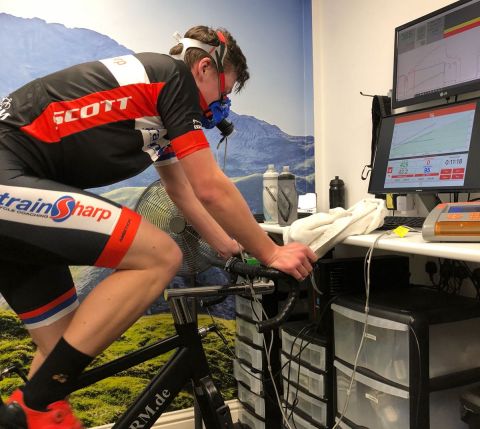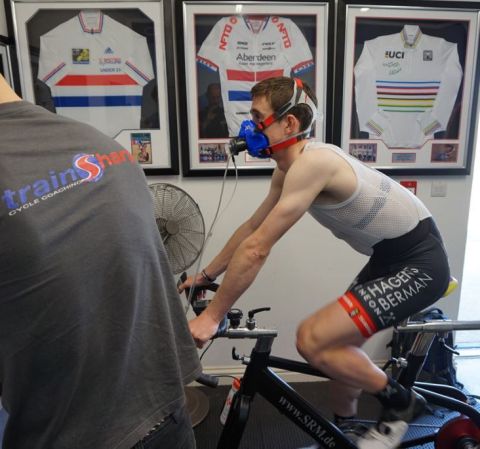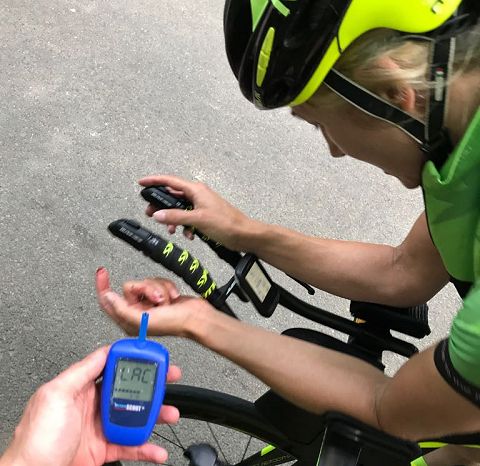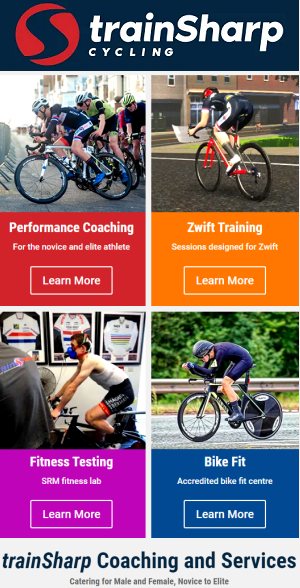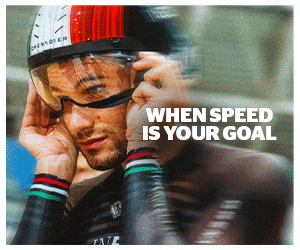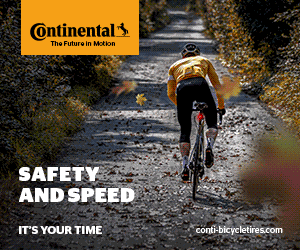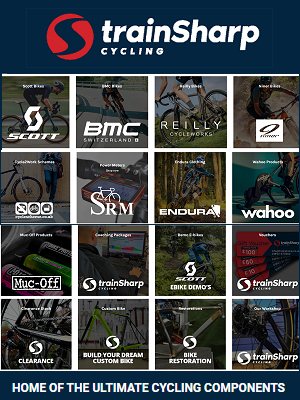As more and more cyclists look to coaches for help in making them go faster, we look at the terms used in sports science thanks to trainSharp sports scientist Connor Murphy
 |
Feature: Understanding Sports Science Coaching Terms
Thanks to trainSharp sports scientist Connor Murphy who has a BSc in Sport and Exercise Science and has a MSc in Sport and Exercise Physiology
Cycling key terms – the science and what they really mean.
Cycling is a world full of specific terminology, which can often be overwhelming, so here is an article explaining what some of the big key terms, with science and what they actually mean in the real world. Obviously books could (and in fact have) been written on each one of these topics, so here will just be a brief summary.
Sweetspot is a term we hear a lot, but what does it actually mean. It is an area in your training zones, where you can deal with a relatively high lactate concentration for a long period of time. Sweetspot is found somewhere between upper zone 3 and lower zone 4, at an intensity below your lactate threshold, at roughly 86-94%. Riding in this area is good for training and improving your FTP or Threshold, as it lets you do a large volume of training, without fatiguing quickly. This is why it is the best bang for your buck, lots of volume at a high intensity, this will create rapid improvements in your FTP. A typical session may be 2 x 20-minute efforts at sweetspot, with warm up, recovery in between and a cool down.
‘Going into the red’ is an interesting term, as it is derived from athletes, rather than science, this doesn’t mean there is no science behind it though. It is a phrase we have all used at some point, to describe how we have felt when we were going super hard, when your legs are screaming at you to stop and you’re frothing at the mouth; we all know exactly how that feels. But why does it hurt so bad!?
Effectively it is all about energy production. To create enough energy (for high power outputs) or specifically ATP we need to utilise carbohydrates. When we do this, we create lactate and associated metabolites as a by-product, this generates cellular metabolic acidosis, that’s why the legs burn!! Along with that, to get enough oxygen into the muscles to create said energy, your heart rate will be near max, to pump enough blood into the muscles. You can only do this for a small period of time, a handful on minutes before you fatigue and often there is no going back quickly from this, if you go this hard in a ride or a race, remember, it is a do or die move, so think wisely.
VO2 max can be defined as the amount of oxygen that you can use, consume and turn into energy. We measure this is two ways, in absolute (L.min-1) or relative terms (kg-1.min-1), so body mass will affect how high your relative values will go. VO2max is a big determinant of endurance performance as it effectively lets us know how much power you can produce whilst using oxygen to create energy. So if you have a high VO2max its likely that you could be a good cyclist.
Maximal Aerobic Power (MAP) VO2 max is important, but arguably MAP is more important. This is the power that you produce at VO2 max, i.e. the most amount of power you can produce whilst still utilising oxygen and using the aerobic energy system. This is one of the key variables we measure to track performance changes.
Lactate threshold is a big one and will encompass Functional Threshold Power (FTP) and Blood Lactate. Your lactate threshold is the point, or power output that you can where you can sustain a concentration of blood lactate for a period of time without fatiguing. Beyond this, an increase in power output will create an exponential rise in blood lactate and ultimately fatigue, but at a power output before your lactate threshold, you will be able to clear the lactate and associated metabolites, faster than it accumulates.
FTP is a term effectively derived from lactate threshold. It can be described as the most amount of power you can sustain for approximately an hour, FTP and lactate threshold are often used interchangeably but are not the same.
Economy: The final key term which is used as a predictor of endurance performance is ‘economy’. This term relates to the amount of oxygen required to generate a specific power output, typically this is 10 mL of O2/1 W. It is affected by numerous anatomical factors, such as muscle fibre type and genetics. This is generally quite hard to improve, but completing things such as weight training can make you more economic, as it allows you to recruit more muscle mass.
Training zones refer to the intensity at which you are riding. Riding at different intensities will bring about different physiological adaptations and as such, riding in different zones can be used to improve your performance and progress on your weaknesses. Typically, there are 6 training zones, but sometimes 7. They are Recovery, Endurance, Tempo, Threshold, VO2 max and anaerobic capacity. How you set these zones is important. We recommend a full fitness assessment, using MAP and lactate threshold to get the most accurate training zones.
Coach – A coach is a term we all know, but what actually is a coach? The answer to this may vary between individuals, but here is our opinion on what a coach should be. A coach should firstly be someone who has the knowledge and experience in and around the sport, being able to provide training that is specific to you, not just give you a standard training plan. They should also be approachable, professional and always be learning, keeping up with all of the new advancements in the sport. They should make you accountable for your training and review your training, making you a much better athlete! At trainSharp, we do all of this and more, working as a team and always improving, we use this to make you the best you can be.
Performance management metrics are the values you see when you upload your rides, metrics like T-score, TSB (Training stress balance), ATL (Acute Training Load) and CTL (Chronic Training Load). These values can be complicated, but they don’t need to be. They were first conceived By Dr Andy Coggan and have become really useful metrics to help plan training, although having said that, it must be remembered they are only metrics and are not the be all and end all, they are simply there to help us monitor and adapt your training. So what are they, let’s start with T-Score;
T-score – This value is a calculated score used to objectively measure sessions completed with power, pace or HR data. The formula takes into account both the workout intensity and duration. If you are working to a plan, then a session will have a target T-Score – in which case you need to train to both the specified duration and intensity to reach the desired goal.
TSB – The training stress balance is really a freshness score. It is calculated simply by comparing your CTL to your ATL. A negative number will indicate you have been doing “harder” sessions then your long term average. Harder could be either in duration or intensity. When your freshness score is negative you will likely feel tired and fatigued. In contrast a positive score indicates you are doing less load then your long term average. This is what you want for a taper or recovery period. In these periods you should start to feel refreshed and ready to knock out a personal best.
ATL – Acute training load is a way of objectively gauging your current training load. It is the short term accumulation of your daily T-scores and uses an exponentially weighted moving average to be calculated. When compared with your CTL, you can see if you are currently training above or below your long term average. By comparing your ATL and CTL you can track if you are building or recovering, and the comparison between the two values gives your TSB or freshness score.
CTL – Chronic training load is a way of objectively measuring your general fitness. It is the long term accumulation of your daily T-scores and uses an exponentially weighted moving average to be calculated. To increase your CTL you are doing (on average) workouts with a higher T-Score – this can be performed through either longer sessions or increasing the intensity.
Overall, the above few key terms only scratch the surface of the terminology that surrounds the cycling world, but the ones included here should get you started. They are very simplified, but are a good summary, so keep that in mind. Good luck with training and racing!
Further Information: trainSharp Coaching
XXXXXXXXXXXXXXXXXXXXXXXXXXXXX
… continued after advert
Cycle Division’s Shop
Send your results as well as club, team & event news here
Other Results on VeloUK (including reports containing results)
- Features, Reports, Results
- Result: Beverley Town Centre Races
- Hill Climb Championships: Change of Course
- Crit Result: Portsmouth Evening Circuits 11
- Crit Result: RCR FatCreations Goodwood Summer Special
- UK Armed Forces Inter-services Road Race
- Report: TLI Cycling ‘Belgium Training Series
- BMCR RESULT: The Ron Day MK Bowl Circuit races (July 23rd)
- RR Result: Bath RC Junior National Series Road Race
- Crit Result: West Thames League 15
- Crit Result: SACA Salt Ayre Tuesday Series 15
- Crit Result: Bath CC Mid Summer Series 2
- Crit Result: Full Gas Summer Circuit Series #17
- TT Result: Ross-On-Wye & Dist CC 25m TT
- TT Result: Ross-On-Wye & Dist CC 10m TT
- TT Result: Kernow Racing Team 10m TT
- News: Men’s Tour of Britain Route (Stage 1 & 2)
- Youth Result: RL360 Isle of Man Youth League 14
- TT Result: Verulam Cycling Club 25m TT
- TT Result: Manchester & District Ladies CA 25m TT
- TT Result: Ferryhill Wheelers CC 25m TT
- Crit Result: Banbury Star Crit Series #2
- RR Result: Lakes Road Club Summer Road Race
- National Circuit Series: Colne
- TT Result: Kings Lynn CC 15m TT
- TT Result: ECCA 10 mile Time Trial
- TT Result: Chorley Cycling Club 10m TT
- TT Result: Houghton CC 25m TT
- TT Result: Bournemouth Jubilee Wheelers 10m TT
- TT Result: Farnham RC 10m TT
- Crit Result: King&Queen of the Bowl Series #13
- TT Result: Kernow Racing Team 10m TT
- Crit Result: Lichfield/Velospeed No Frills at Curborough #7
- TT Result: Swindon RC & Swindon Wh 50m TT
- Crit News: Spatzwear Friday Night Crit Series #6 | YBC
- GB News: Paracycling Squad for Paris 2024
- Crit Result: Thanks Crit it’s Friday 7
- Crit Result: Omega Portsmouth Circuits 6
- Result: BMCR National Road Bike TT Championship
- Crit Result: Ride Revolution Coaching Summer Crits #2
- Crit Result: Shutt Velo Rapide Hitters Crits Rd2
Other News on VeloUK
- Hill Climb Championships: Change of Course
- TT Result: Ross-On-Wye & Dist CC 25m TT
- News: Men’s Tour of Britain Route (Stage 1 & 2)
- GB News: Paracycling Squad for Paris 2024
- Ribble Redefines Road with launch of Allroad
- BMCR: National Road Bike Time Trial Championship
- SUNDAY: Bath Road Club Junior National Series Road Race
- TLI CYCLING FEATURE: SUPER4SERIES
- NATIONAL CIRCUIT SERIES UPDATE 2024
- News: Josh Tarling Extends Contract at Ineos
- Tour of Britain for Men 2024
- News: Connor Swift Extends Contract with Ineos
- Updated GB Olympic Team News
- Sunday: 2024 Youth Circuit Race Championships (Cyclopark)
- ROBBED BY THE HIGHWAYS AGENCY – National Highways
- Startlist: BMCR National Road Championships E/F/G/H
- OLYMPIC NEWS – Team GB Announces First Riders for Olympics
- News: Alex Richardson Retires
- New Releases from Shutt Velo Rapide
- STARTLIST: Men’s British Road Race Championships
- STARTLIST: 2024 Women’s British Road Race Championships
- Startlist: 2024 CAMS Yorkshire Classic Road Races
- Startlists: 2024 Circuit Race Championships
- Startlist: CAMS Ronde van Wymeswold
- Startlists & 2023 Results: National Time Trial Championships
- NEWS: Star Studded Line Up for National Road Champs
- Riders so far: London Dynamo Summer Road Races
- Women’s Tour of Britain Startlist (provisional)
- News: Lincoln winner hit by car
- Entries Wanted: Ilkley Cycles Races
- GB Team Named for Women’s Tour of Britain
- STARTLISTS: NW, Yorkshire & NE Regional RR Championships
- Startlists: East Midlands Road Race Championships
- News: Ribble Rebellion Race USA’s Armed Forces Cycling Classic
- TT Result: Legato Racing Team 10m TT
- Pre-Race Rider Quotes: Ford RideLondon Classique
- STARTLIST: Witham Wheelers Road Races
- Team News: Tour of Britain for Alba Development RT
- Startlist: Totnes Vire 2024
- Starters: NW Junior/U23 360cycling Two Day






